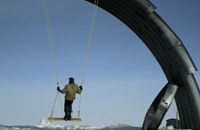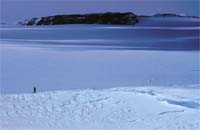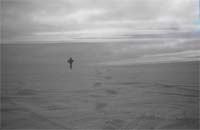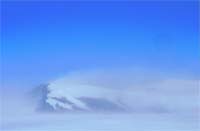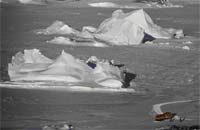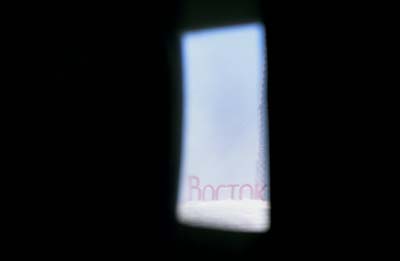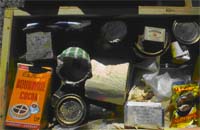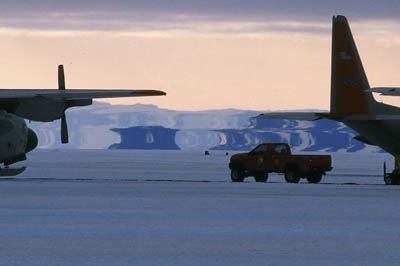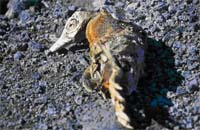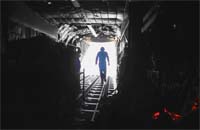Time on Ice
originally published, in a slightly different version, by Isotope, Fall/Winter 2005

"On the question of time, science is bound to be solipsist. The problem of time is a problem of choice."
—John Berger, Painting and Time, in The Sense Of Sight
Nov. 7, 2000: I'm struggling with three dimensions, and lost in the fourth. A storm is buffeting the base. It's hard to see anything through the whiteout and blowing snow. Clarity and definition are eroded, white on white through white. Whether walking through the ground blizzard, or just staring out the window of my empty dormitory lounge, I see a world dusted and hammered with white. The snowy polluted shoreline, the snowy bulldozed hills: all of it stands pretty and flat-sketched against a whitewashed backdrop.
On the edges of town, only the memorial crosses have weight, dark as ebony silhouettes against the erasure. During these "Condition 1" storms, we, our imported presence in the tabula rasa of the Antarctic, are the only third dimension available. Try to go for a walk, however, and suddenly it's a struggle to believe even your existence here. We cast no shadow. We make no more than an off-white streak across a blank map.
McMurdo Station, Antarctica, is the outpost of rationality the U.S. has struggled to maintain on the edge of the southern continent for 50 years. The largest base in Antarctica, McMurdo is now made up of over 100 buildings, three airfields, and a summer population of over 1100 people. Two thirds of us are not researchers of any sort: we manage operations and logistics so that science can trudge out into the elements to gather data. Yet we have inquiries of our own, the existential questions that arise when we place ourselves in this often liminal space. I've been taking notes on internal and external weather since 1994.
Later, walking out of the dorm, as I've done countless times for six summers now, I felt a strange calm swirl around me as I crossed the storm-laced open ground on my way to the galley. Time curled in on itself. I knew where I was, but had no idea when I was. I realized with pleasurable fear that at that moment I could not identify which summer I occupied. The memory of my time under Antarctic skies had sintered to the present. Time was subject to the whiteout.
As I walked out into the snow I walked into my notebooks. I had entered my written stratigraphy of summers in which old and new paths overlap. I have written my self, as well as this sense of geography that erases my self, into being. My few strange steps brought me within the realm of unpunctuated unknowing, the cloud of understanding that describes my time on ice.
Nov. 20, 1912:
"... a strong north-east wind blew, with falling snow. Nothing could be seen but a white blanket, above, below and around; so, with sudden death lurking in the bottomless crevasses on every hand, we stayed in camp."
—Frank Wild, in Home Of The Blizzard
Journal after journal from early exploration spills over with "stay-in-camp" days. Storms or ground blizzards beset the sledgers and dog teams each time they set out to lay depots, attempt the South Pole or Magnetic Pole, or head for home. The main endurance of the Endurance expedition lay in the many months of waiting on the floes and Elephant Island, rather than in the wild journeys in small boats. Roald Amundsen was sent limping back to the Bay of Whales after sledging for the Pole too early in the season. Robert Scott took chances with supplies and ran into horrific weather and temperatures that broke his gamble. He is still in camp.
They read what few books they had over and over (Shackleton spent one storm rereading Much Ado About Nothing), wrote understatements about the weather in their journals, talked incessantly of food, and generally sought to be civil with each other while laying in cramped quarters for days on end. Rather than going outside, the men dug a hole under the tent's ground cloth to serve as their toilet. One shivering man would pull aside the cloth and remove the hole's lid while the others rolled away toward the tent wall.
Time in the tent offered the only rest men would have on epic trips, but the stay-in-camp days were just as likely to drain them of strength. Lying in stiff cold canvas clothes in a frozen caribou skin sleeping bag, under a thin canvas tent whipping like a flag in the gale, burning many more calories per day than they ever took in, "camp" was sometimes little more than a ready coffin. These men, time and again, were forced to wait for release, to wait for whatever the ice would allow them to do. It was part of their dialogue with Antarctica: the wind spoke, and the men lay down to listen.
The ice still dominates the conversation. Flights are cancelled because of weather nearly every week. McMurdo has the occasional Condition 1 storm which restricts all personnel to whatever building they're in, and field camp groups expect to be tentbound at some point in the summer. Waiting for McMurdo's weather to clear, I've spent up to 15 days in New Zealand, up to 10 extra days at field camps, and 5 days bedridden with I.V. antibiotics and a growling appendix.
Most of the Antarctic is empty space. The coasts are parentheses, containing only whiteness, an empty set. Just as if you took a microscope to examine the textures of a blank page, so the East Antarctic ice cap appears to the naked eye. Ruffled hardened snow stretches from your feet out across an area larger than China.
The experience of interior Antarctica is liminal, this strange stepping onto a frozen ocean, but there is little variety in that liminal space: a walk through any temperate landscape provides any number of imagined and scientific thresholds. Here we reside on the aesthetic and biological margins of life on Earth, but there are few borders within it.
The ghetto of time zones around the South Pole notwithstanding, time finds few handholds here. Timelessness surrounds us in a landscape defined by a continuum of unframed moments. In the interior, I feel no story, no beginning or end.
This irrational experience of Antarctic time is the "native" experience, and the rational notions of mind and space which drive science have little to say about it, cannot recommend or obviate it.
We're so tied to our work schedules that we quickly outgrow the novelty of a summer day that is many months long. We punch the clock each workday while the sun rides the south polar thermal above and around the horizon. The two phases of the year that do resemble the temperate day/night cycle are ephemeral, twilight aberrations in the midst of the passage between light and dark. Despite the uniformity in our light, however, Antarctic bases keep a wild variety of times. Many set their clocks to match the port from which they deploy, while some are set to their home country. Some match their time zone, while many do not.
While stations that are neighbors communicate often, most have no occasion to chat across the continent. On those occasions, however, we reference Zulu time (Greenwich Mean Time) as a standard. Zulu is 12 hours behind McMurdo time, which is New Zealand time. The South Pole, because it is American, is on New Zealand time as well, though it has each of the world's time zones at its doorstep. The Italians deploy through Christchurch and are thus also on New Zealand time. Vostok Station, like each of the widely-scattered Russian bases, is on St. Petersburg time. Dumont d'Urville, the largest French base, is on Australian Eastern Standard Time because like the Australians crew and cargo arrive by ship every year from Tasmania. The Australian bases of Casey, Davis, and Mawson, strangely enough, are respectively 3, 4, and 5 hours behind A.E.S.T.
If I want to call my family in Maine, I have to keep in mind that I'm anywhere from 16 to 18 hours ahead, depending on daylight savings time in both places. Actually, I tend to think of them as six to eight hours ahead yesterday.
Daylight savings in Antarctica: we follow it, to stay in synch with the Kiwis, but otherwise it's about as useful a behavior as South Pole setting out a rain gauge. Out in the field camps, "local" (McMurdo) time is what we use with each other and for flight operations. But weather observations are passed back to the weather office in McMurdo as Zulu time, and planned radio comms are set up either on local or Zulu. Both of these are described via military time, i.e. on the 24-hour clock. So, for example, I might have comms with MacOps at 1330 local, but give a weather ob to MacWeather half an hour later at 01 Zulu.
Back in town, or at Pole, we have dayshift and nightshift, equally strange concepts whether it's summer or winter. But they have their effect: separation from the rest of the community, and the slightly different cant of light on the ground during summer "nightshift," give me the sense that indeed one cold empty day could be made distinct from another.
Dec. 2, 2001: Abandoning our snowmobiles where the glacier ends its 300 foot thick flooding of Trudge Valley in the Allan Hills, Julian and I took off to explore a little bit of our backyard Mars. Our two-person camp was several miles behind us on the edge of the Odell Glacier. We'd driven upstream to see what this part of the hills could offer. We were in the middle of a three-month job building and maintaining a runway on the lower Odell. The Allan Hills are a set of barren ridges and valleys nearly drowned by the ice of the East Antarctic ice cap as it pours between the peaks of the Transantarctic Mountains. Walking these rust-colored valleys, we are little different than the Mars Rovers, roaming and photographing with frequent stops to pick up stones.
Down on the valley floor, we were surprised to see two battered orange Scott tents pitched at the foot of the glacier. We thought the nearest humans were in the Dry Valleys somewhere, 60 crevassed miles away. The two geologists from New Zealand's Scott Base were surprised to have two Yanks smiling and helloing them from outside their tents. Unfortunately, we woke them from a sleep schedule opposite our own: in order to find gaps in the helicopter schedule for their flight support, they'd shifted their morning to midnight. We stood around and talked like neighbors for a few minutes before Julian and I continued up the valley, leaving them to settle back into slumber.
Though we're out here alone together for a few months, Julian and I just met in October. We shook hands in McMurdo and starting packing for the trip. Over the last several weeks, I've come to admire especially his attitude toward the Antarctic. He fell in love with it years ago, like me, but has been very careful to come back only occasionally. Julian will work a summer on the coast, then take a few years off; then another summer in the interior, followed by more years off. "I like to leave when the party's good," he says. I think it's also about keeping a poetic affair from turning prosaic.
We stopped again a mile farther, because Julian stumbled across a piece of petrified wood lying in the dolomite and sandstone gravel. Then I spotted one. Over the next few minutes we realized that the entire valley floor was littered with thousands of fragments of 220 million year old Glossopteris forest. Even much of the gravel was splintered fossil.
A now-extinct seed fern with tongue-shaped leaves, Glossopteris grew to a height of 12 feet. The dense fine-grained stone is the color of a November cloud, with every other growth ring mineralized black. Many of the fragments were also ventifacted; that is, they had been polished over millennia by wind-driven sand. They ranged in size from clumps like unabridged dictionaries to chips like Scrabble tiles.
Turning this history over in my hands was, to me, like hearing voices in a river. Here millennia flowed by while Antarctic time stood still and yawned. Only the stars look at this wood as if it were fresh grass. For me, standing here in the anteroom of the ice age, living a lifespan similar to the tree that became this stone, mortality and eternity seem like opposite sides of the same faceless coin. On an island of stone in a sea of ice, on a continent of no-life surrounded by the sea of plenty, lay these pale memories once fed by rain. The continent these trees inhabited is the same one whose dead land Julian and I are walking, but when they grew the ice was a distant mirror and the equator a closer neighbor. The passage of geologic time has been made palpable by this wood, as if each stone were a stem cell of time.
Most fossils are found in places where new forms have replaced them. Like us, for example. But nothing in Antarctica says to the mind "This is a tree," or "This is a good place for a tree." It's not even a good place for us.
Two hours later, on our way back to the glacier, swinging wide across a small sandstone mesa to see what we could see, Julian and I came across whole sections of Glossopteris trunks emerging from solid rock. Mostly they were at angles to the surface, but one or two were near vertical, looking for all the world like a stump from a Triassic cutting.
Then I found the most intriguing stone I have ever seen. About the size of a mittened fist, it was yet another gray and black striped piece of petrified wood, but it had been carved by the wind into an object of remarkable beauty and polished abstraction. It lay exposed on bedrock, where wind is able to carve its sculptures in the round, eroding stones at an estimated rate (for dolomite) of about .1 to .3 cm per 1000 years. Small grooves like the spacing between harp strings had been channeled into it by winds howling down from the ice cap. These grooves ran at right angles to the growth rings that swirled in their own elegant pattern under the smooth surfaces of the stone.
This stone is a plaything of time, or vice versa: organismic time has merged with geologic time, and together they are here at the mercy of glaciologic time, and under the thumb of the time it will take wind to grind this fossil into dust.
The loose stitches time takes to unite us fingered by this cold and left undone.
The substance of cold is the substance of time.
Dec. 4, 2001: Antarctica is the best source on Earth for the bits of space punctuation we call meteorites, and the blue icefields inland from the Allan Hills are one of the best-known areas for such finds. The Mars rock that NASA claimed showed signs of life was found there. These icefields mark where the East Antarctic ice sheet is locally dammed up by the Transantarctic Mountains.
The ice streams of East Antarctica are forced upward as they flow toward the mountains, but in some areas are steadily ablated (i.e. wind-eroded) by dry katabatic winds. Katabatics are gravity-driven cold masses of air that fall with fury from the ice caps down to the coast. All meteorites that have dropped from the heavens into these ice streams over millennia are swept up in the ice, then left high and dry on the blue surface of the ablation zones. Since 1976, the Antarctic Search for Meteorites (ANSMET) teams have found over twelve thousand stones, pebbles, and specks waiting for them.
The Odell is a blue ice glacier well downstream of the famous icefields, a narrow thread tucked between peaks. It's not a likely place to find meteorites, because of the complications of such a journey. I'm still not sure how mine arrived.
Julian and I had moments earlier finished drilling the final hole for our runway markers. Three weeks of construction were complete, and we could finally set the oil-spewing auger aside. One of the things we hoped to do in our spare time was look for meteorites. Two ANSMET guides had flown out to our camp a week before, to look over the airfield. They couldn't stand the thought of a plane running over a meteorite.
I had pressed Johnny and Jamie, the ANSMET guys, for precise descriptions of the meteorite types, not least because the katabatics like to hurl small shiny bits of suggestive dolomite from the Allan Hills onto the Odell.
Johnny, a quiet, grizzled man who has been guiding the meteorite teams for some 21 years, gave me a simple answer. "Just look for stones out of context." Otherwise, we'll go crazy picking up everything. "Where you see a rock by itself, or a larger one among pebbles, go check them out. The wind-blown rocks will all be the same size. Then look for the fusion crust." A fusion crust is the melted surface of the rock that once hurtled through our atmosphere before plunging into the cold bath of the ice cap. In a cartoon that kept playing through my mind, I imagined finding one that was still sizzling.
So as we happily turned our snowmobiles away from the drilling work, ready to eat lunch back at our camp, some three miles away, I swerved over to a too-large suspect. I'd picked up too many rocks already to get excited, but this one was big. It looked like a softball hit out of the park about a million years ago. But it wasn't dark enough, I thought, and had no smooth crust. Sure it was dolomite, I finally reached down with my filthy oily glove and turned it over, only to find a perfect dark chocolate fusion crust. I gasped like a schoolgirl and dropped the beast back onto the ice.
My find, at about 5.2 kg (11 ½ pounds), was one of the largest of the few hundred meteorites found this year. Normally an ANSMET team will find six or seven hundred in a summer, but they lost a precious week pinned down by winds of up to 60 knots. Instead of gathering meteorites, they were losing tents. Two weathered fragments lay nearby, which fit nicely onto the side I had first seen. It was an ordinary chondritic meteorite, the most common type. But it was big, it was heavy, and by the craziest luck in the world, it had sizzled into my life.
My hands, the first hands to have touched this object of deep time, had no idea how to tell my mind what they held. Or perhaps the reverse is true: my hands said "stone", while my mind said "asteroid". How long did it take to travel from outside our atmosphere to the innards of the ice cap? Seconds, I suppose. How long has the journey been since then? No one will ever know. How long was this fragment moving through space before it snagged in our planetary net? About 4.55 billion years, according to authorities, the same age as the Earth. 4.55 billion years: I feel like I should play God with this thing, setting it gently back into space with a dressing of organic chemicals (is 2-cycle oil good enough?), and expect it to sprout life in some distant epoch.
Here's something that looks at the petrified Glossopteris pieces as if they were grass, I thought. In the course of a few Earth days, my hands held both dinosaur food and firecracker fragments from the Big Bang. I was luck itself.
McMurdo is a status society, our status being primarily based on how much of our lives we've spent on the ice. A summer contract is five months, while a winter contract might last seven to ten months. A year contract on the ice generally lasts 13 months. Back home, I tell people that I've worked for eight summers in the Antarctic, but down here I'm ranked by my 43 months. The sum of our contracts gives us our "ice time," this sum of months we're asked to write down on our pre-deployment paperwork.
This ice time is taken by the always controversial Housing Department and multiplied by whatever value they've associated with our jobs. A low-paying job gives an employee low housing value. These values are biased toward managerial positions, regardless of ice time. A new administrative arrival, even if they cannot find their dorm, will not end up in a dorm with a bathroom down the hall.
Every summer there's a station-wide fit of ranting about Housing decisions. Old-timers grumble about special favors while new folks complain about what seems like random punishment. October is filled with stories of couples split into different rooms, and with the sound of weeping supplicants coming from the Housing office.
I knew an Assistant Housing Coordinator who in the last months of the summer, knowing she would never return to McMurdo, quietly issued herself a private room. She put the beds together, set up a mini-bar, and lived like a queen. It was her first and last season in Antarctica. She lived in coastal Alaska where, as she said, "I can have the same view and none of the bullshit."
Housing is an obsessive topic for the working community. "Where are you living?" is an everyday question followed up with a "Huh" that means either "Oh, sorry to hear it" or "That makes sense" or "How did you end up there?" New employees in low-caste jobs quickly learn that answering these questions amounts to announcing their social rank. When three or four stunned Dining Room Attendants find themselves sharing a windowless room upstairs in building 155, they know that American Antarctica has put them in their place.
Ice time is also a social standing that modifies, to whatever extent Housing acts logically, the decision not to become management. If you work as an Equipment Operator for a decade, you still end up living on the water view side of Dorm 209 next to researchers and administrators.
When two people want to share a dorm room (rather than being given a roommate with similar ice time), Housing will average their housing points: one summer my friend Nicholas' lesser ice time brought me down from Dorm 207 to Dorm 204, but the next summer we landed in Dorm 208. The fact that he had fudged his ice time ("If they're too lazy to look it up, then they deserve whatever I tell them") may have helped our case.
Dec. 18, 1994: A small berg broke off the McMurdo Ice Shelf a few years ago, but still waits for release from the sea ice just meters from its source. To reach it, a flagged trail guides walkers several miles out from McMurdo. Because the sea ice rarely breaks out to the edge of the shelf, the berg may be hunkered down for some time to come. So it sits like a lost dog, neither glacier nor ocean, neither origin nor destination.
Chewing through my McMurdo leash, I walked out on my own on a nearly overcast Sunday, our only day off. "Safety in numbers" is an Antarctic mantra, and no one is supposed to walk alone outside of town or the roads. But privacy is a rarity in town, and living here means several months of living on someone else's schedule. So I headed out for an impromptu date with this quiet behemoth. Where did this ice begin? Which is to say, when did it begin? What impossible stories might be told about the journey of a piece of ice from its inland home to this coastal end? Astray from the monotonous ice shelf, it is now a colony of crystals irrelevant to the great flood that brought it here, part of the charismatic diaspora of Antarctic icebergs. The berg is a chapter in a history perhaps too rich for data, a balkanization of ice and time.
I walked alone in a slow circle around it. It took perhaps ten minutes to do so, undulating up and down with the snowdrifts, stopping at points to see how a few summers of sunshine have sculpted the walls. A curtain of slow drips ceased as the sky clouded over. I felt like a fly buzzing in the ear of a ruined blue titan.
New Year's Eve, McMurdo: Celebrating the passage of time on a continent that resembles a ventifacted clock face. And what is time telling but a foundation of data gathering? Our inventions of calendar and clock led eventually to the machine-age which now powers our comfy existence in this reductionist space. "Most of time and space is like Antarctica," says Sara Wheeler, but not here, not tonight. We have sintered time and space to ego. It's time to dance.
Time is a type of weather, a form of weather, a weather. Patterns exist amid a universe of tendencies. Some of the tendencies form around our mental habits, and some are storms that consume us.
On the ice, fierce weather and time may fuse into a few violent, meditative brushstrokes: an experience, I have found, of accidental transcendence.
But Antarctic time is most often composed of days without measure, summer days made identical by the sun, which sits high like a bulb without shade on the blue wall of the sky. And the distance from our feet to the unreachable horizons owes nothing and gives nothing to time. This vast glacier of sky drowns in integrated silence the ticking of our little movements.
|
© Copyright Jason Anthony All rights reserved. |


